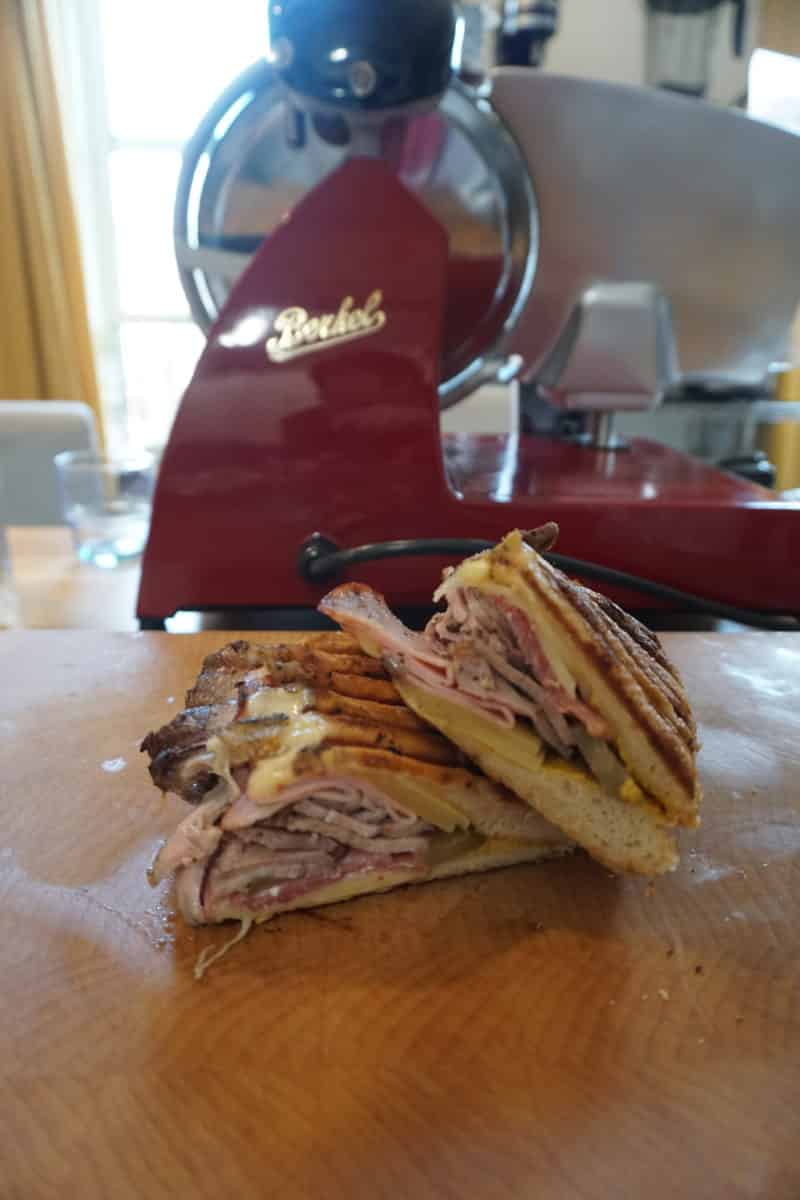One of the great joys of owning a Berkel Red Line 250 is how easy it makes it to entertain, and to slice cheese, meat, and fruit for snacks, charcuterie plates, or even just to put directly into your mouth straight from the slicer.
If you’re going to invest in such a beautiful slicer, though, it makes sense to find uses for it which aren’t limited to when you want to have guests over, and one of the best applications has to be sandwiches. And one of the best sandwiches you could ever make? A Cubano, which melds citrus-marinated roasted pork with Genoa-style salami (if you’re making it Miami-style), Swiss cheese, honey baked ham, pickles, and yellow mustard.
While the salami, ham, and Swiss is something you can buy at any deli counter, the roasted pork you’re going to want to make yourself, and the Red Line 250 makes it possible to slice it beautifully. Bear in mind that the warmer the meat, the more difficult it will be to slice, so make sure you let the meat come down to room temperature before you slice it up (it’s also great sliced straight out of the fridge the next day).
Ingredients
- •1.8 Kg (4 pounds) boneless pork shoulder
- •10 medium cloves of garlic, grated on a microplane grater
- •30 ml (2 tablespoons) kosher salt
- •15 ml (1 tablespoon) dried oregano
- •15 ml (1 tablespoon) ground cumin
- •10 ml (2 teaspoons) freshly ground black pepper
- •120 ml (½ cup) freshly squeezed lime juice (approximately juicy 3-4 limes), divided
- •60 ml (¼ cup) freshly squeezed orange juice ( approximately 2-3 juicy Naval oranges)
- •8-10 soft white hero rolls or Cuban bread (Pan de Agua) if you can find it
- •Yellow mustard
- •Sliced Genoa-style salami
- •Sliced Swiss cheese
- •Sliced honey baked ham
- •Thinly sliced dill pickles
- •113 grams (4 ounces wt) unsalted butter, softened to room temperature


Preparation
- Place pork shoulder on a large plate or a sheet pan and use a paring knife to poke holes approximately 2.5 cm (1 inch) deep all over the exterior of the meat. If the roast came trussed or in netting, don’t worry about removing it—just try not to cut the string while you’re poking the holes. Once the roast is covered in small cuts, set it aside.
Place the garlic, kosher salt, oregano, cumin, and black pepper into a small bowl. Mix together well and gradually add in lime juice, 15 ml (1 tablespoon) at a time, until you’ve created a thick paste; it should take 30-45 ml (2-3 tablespoons) of juice to reach the right consistency.
Slather the garlic spice paste all over the exterior of the roast and massage it thoroughly into the surface, doing your best to work it into the small incisions you made earlier. Once you’re satisfied you’ve done your best (which should only take a couple of minutes) place the roast into a gallon-sized zipper lock-style bag. Pour the remaining lime juice and the orange juice into the bag, making sure the juice surrounds the meat on all sides. Fold over the top of the bag, squeeze as much air out as you can, and seal the zipper lock.
Place the bag in a refrigerator, seal side up (so that it doesn’t leak) and let marinate for at least eight hours, or overnight. Turn the bag occasionally if you’re worried part of the roast isn’t being exposed to the juice.
Turn your oven to 149°C (300°F) and while it preheats cover a sheet pan with a double layer of aluminum foil that’s large enough so that you can gather it around the roast to form a loose bubble. Place the roast on the foil, pour the liquid from the bag over it, and pull up and surround it with the foil. Roast until it reaches an internal temperature of 54°C (130°F), approximately 2 hours.
Remove the roast from the oven, unfold the foil so that the roast is exposed to the air, and increase heat to 163°C (325°F). Roast, uncovered, until the internal temperature reaches 63°C (145°F), about 30-45 minutes, basting every 15 minutes.
Remove the roast from the oven and let it rest uncovered until it’s come to room temperature, approximately 1-2 hours.
Once the roast has cooled to room temperature, slice it in half crosswise. Place half of the sliced roast onto the meat table of the Berkel slicer, secure it, and set the blade to 2.5, or to your preferred slicing setting. Slice the desired amount of meat and set aside.
Slice your desired number of rolls in half and, for each sandwich, spread your preferred amount of yellow mustard on each piece of bread. Layer on the salami, Swiss cheese, honey baked ham, dill pickles, and sliced roasted pork shoulder, taking care not to overfill the sandwich. Close the sandwich and spread the exterior of each side of the sandwich generously with the softened butter.
Preheat a heavy skillet (preferably cast iron) over a medium flame; do not allow it to get too hot. Place a sandwich into the preheated skillet and press down on it with a spatula so that as much of the bread as possible is touching the pan. When the bread has browned nicely, about one minute, carefully flip the sandwich and brown the other side. Remove from the pan when fully browned, slice in half, and serve. Repeat as needed.

